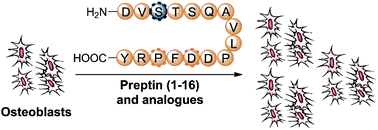Structure activity relationship study on the peptide hormone preptin, a novel bone-anabolic agent for the treatment of osteoporosis†
Abstract
Preptin is a 34-residue pancreatic hormone shown to be anabolic to bone in vitro and in vivo. The bone activity of preptin resides within the (1-16) N-terminal fragment. Due to its peptidic nature, the truncated fragment of preptin is enzymatically unstable; however it provides an attractive framework for the creation of stable analogues using various peptidomimetic techniques. An alanine scan of preptin (1-16) was undertaken which showed that substitution of Ser at position 3 or Pro at position 14 did not inhibit the proliferative activity of preptin in primary rat osteoblasts (bone-forming cells). Importantly, Ser-3 to Ala substitution also showed a significant activity on osteoblast differentiation in vitro and increased the formation of mineralised bone matrix. Additional modifications with non-proteinogenic amino acids at position 3 improved the stability in liver microsomes, but diminished the osteoblast proliferative activity. In addition, to provide greater structural diversity, a series of macrocyclic preptin (1-16) analogues was synthesised using head-to-tail and head-to-side chain macrolactamisation as well as ring-closing metathesis. However, a detrimental effect on osteoblast activity was observed upon macrocyclisation.



 Please wait while we load your content...
Please wait while we load your content...